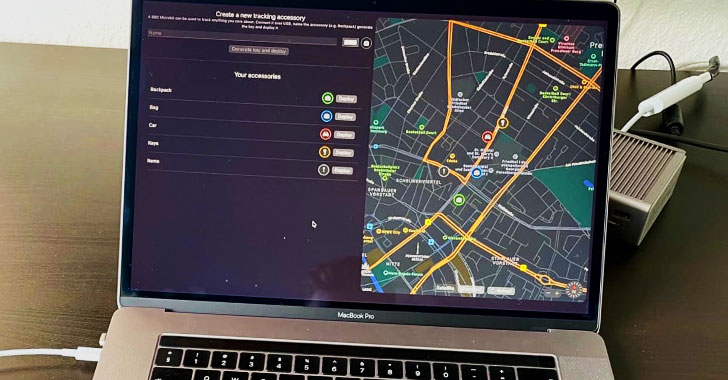Cybersecurity researchers on Thursday disclosed two distinct design and implementation flaws in Apple’s crowdsourced Bluetooth location tracking system that can lead to a location correlation attack and unauthorized access to the location history of the past seven days, thereby by deanonymizing users.
The findings are a consequence of an exhaustive review undertaken by the Open Wireless Link (OWL) project, a team of researchers from the Secure Mobile Networking Lab at the Technical University of Darmstadt, Germany, who have historically taken apart Apple’s wireless ecosystem with the goal of identifying security and privacy issues.
In response to the disclosures on July 2, 2020, Apple is said to have partially addressed the issues, stated the researchers, who used their own data for the study citing privacy implications of the analysis.
How Find My Works?
Apple devices come with a feature called Find My that makes it easy for users to locate other Apple devices, including iPhone, iPad, iPod touch, Apple Watch, Mac, or AirPods. With the upcoming iOS 14.5, the company is expected to add support for Bluetooth tracking devices — called AirTags — that can be attached to items like keys and wallets, which in turn can be used for tracking purposes right from within the Find My app.
What’s more interesting is the technology that undergirds Find My. Called offline finding and introduced in 2019, the location tracking feature broadcasts Bluetooth Low Energy (BLE) signals from Apple devices, allowing other Apple devices in close proximity to relay their location to Apple’s servers.
Put differently, offline loading turns every mobile device into a broadcast beacon designed explicitly to shadow its movements by leveraging a crowdsourced location tracking mechanism that’s both end-to-end encrypted and anonymous, so much so that no third-party, including Apple, can decrypt those locations and build a history of every user’s whereabouts.
This is achieved via a rotating key scheme, specifically a pair of public-private keys that are generated by each device, which emits the Bluetooth signals by encoding the public key along with it. This key information is subsequently synchronized via iCloud with all other Apple devices linked to the same user (i.e., Apple ID).
A nearby iPhone or iPad (with no connection to the original offline device) that picks up this message checks its own location, then encrypts the information using the aforementioned public key before sending it to the cloud along with a hash of the public key.
In the final step, Apple sends this encrypted location of the lost device to a second Apple device signed in with the same Apple ID, from where the owner can use the Find My app to decrypt the reports using the corresponding private key and retrieve the last known location, with the companion device uploading the same hash of the public key to find a match in Apple’s servers.
Issues with Correlation and Tracking
Since the approach follows a public key encryption (PKE) setup, even Apple cannot decrypt the location as it’s not in possession of the private key. While the company has not explicitly revealed how often the key rotates, the rolling key pair architecture makes it difficult for malicious parties to exploit the Bluetooth beacons to track users’ movements.
But OWL researchers said the design allows Apple — in lieu of being the service provider — to correlate different owners’ locations if their locations are reported by the same finder devices, effectively allowing Apple to construct what they call a social graph.
“Law enforcement agencies could exploit this issue to deanonymize participants of (political) demonstrations even when participants put their phones in flight mode,” the researchers said, adding “malicious macOS applications can retrieve and decrypt the [offline finding] location reports of the last seven days for all its users and for all of their devices as cached rolling advertisement keys are stored on the file system in cleartext.”
In other words, the macOS Catalina vulnerability (CVE-2020-9986) could allow an attacker to access the decryption keys, using them to download and decrypt location reports submitted by the Find My network, and ultimately locate and identify their victims with high accuracy. The weakness was patched by Apple in November 2020 (version macOS 10.15.7) with “improved access restrictions.”
A second outcome of the investigation is an app that’s designed to let any user create an “AirTag.” Called OpenHaystack, the framework allows for tracking personal Bluetooth devices via Apple’s massive Find My network, enabling users to create their own tracking tags that can be appended to physical objects or integrated into other Bluetooth-capable devices.
This is not the first time researchers from Open Wireless Link (OWL) have uncovered flaws in Apple’s closed-source protocols by means of reverse engineering.
In May 2019, the researchers disclosed vulnerabilities in Apple’s Wireless Direct Link (AWDL) proprietary mesh networking protocol that permitted attackers to track users, crash devices, and even intercept files transferred between devices via man-in-the-middle (MitM) attacks.
This was later adapted by Google Project Zero researcher Ian Beer to uncover a critical “wormable” iOS bug last year that could have made it possible for a remote adversary to gain complete control of any Apple device in the vicinity over Wi-Fi.



